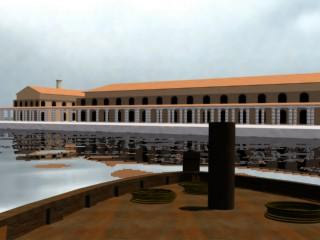Reconstruction Methodology part five – Ships and Boats
E. Ships and Boats
Archaeological evidence has greatly enhanced our knowledge of Roman shipping in recent years. There are hundreds of shipwrecks from the Roman period (Parker 1992), which have done much to develop our understanding of hull construction and to illuminate some of the fundamental points of shipbuilding and sailing, such as mast position.

The best evidence for the sailing ships that plied the waters of the harbours at Portus comes from the remains of ships that were excavated in the Porto di Claudio in the late 1950s. And which are currently on display in the Museo delle Nave Romane di Fiumicino. The rig which is visible in the foreground of the ships for the early imperial and late antique animations is based on the evidence from recent land and maritime excavations, as well as textual and iconographic sources (Casson 1995). In particular, the dead-eye is based upon finds from recent excavations at the Roman port of Myos Hormos (Qusier-al-Qadim) in Egypt.
The amphorae on the deck of the early imperial ship are of a type that is known to have been produced in early imperial Egypt, while those on the deck of the late antique ship are known to have been produced in Africa at this time to carry olive and which were exported to Portus and Rome in large quantities. Available evidence suggests that cargoes unloaded from sea-going ships at Portus were later placed on barges which were then towed up-river to Rome, and then back again. Thus the animation that takes the viewer along this latter journey, from the Tiber along the “Fossa Traiana” to Portus, is based on the principle that the boat visible in the foreground was a barge (caudicaria navis). The remains of one of these is on display in the Museo delle Nave Romane di Fiumicino.
